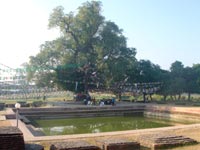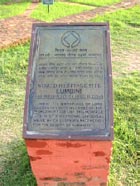 Lumbini is the place where the Prince Siddhartha (the Buddha) was born and took his first seven steps and uttered an epoch-making message to the world. In the 6th Century B.C.E., in the month of Vesaka (which usually falls in May), Maya Devi, the queen of the Sakya Kingdom gave birth to Siddhartha at Lumbini grove.
In 249 B.C.E., the Emperor Asoka of the Maurya Dynasty made a pilgrimage to the place and erected a stele bearing an inscription stating that Shakyamuni Buddha was born there, thus reestablished the link to this place. The site was visited by many pilgrims, including the Chinese monk Hiuen-Tsang (7th century C.E.). After the 14th Century, the place was neglected for almost 600 years until an archaeological survey in 1896 done by General Khadga Shamsher Rana and Dr. A. Fuhrer. More discoveries were made in the 1930s in a large scale excavation at the site led by General General Keshar Samsher Rana.
 The Pushkarini Pond and the
Nativity Tree at Buddha's birth place
In 1970, an international committee to manage the development of Lumbini was formed, and Prof. Kenzo Tange of Japan was assigned to create the Lumbini Master Plan. The master plan was approved by the UN and HMG/Nepal in 1978. The Lumbini Development Trust was formed in 1985 to be in charge of the overall development and management of the Lumbini project.

Representatives of various countries and Buddhist communities who were awarded land on this site have been engaged in restoration and development. Monasteries, stupas, a museum and other amenities are under construction, and the ancient Maya Devi temple has been restored.
Inscribed on the slate (right): "World Heritage Site" / "Lumbini" / "The Birthplace of Lord Buddha" / "Lumbini, the birthplace of Load Buddha has been inscribed on the World Heritage List. This Heritage Site is of exceptional universal value which deserves protection for the benefit of humanity."
|



